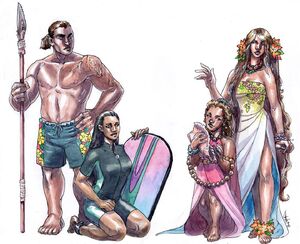
Menehune are the native fae of Polynesia, found in large numbers in Hawaii, Tahiti, and Easter Island. They even have close cousins on New Zealand and New Guinea. Like the nunnehi, they stick close to their traditional way of life and reject modern technology and the attendant Banality.
History
The menehune came to Hawai'i with the Polynesians, though the islands were inhabited before this by the people of Mu. For thousands of years, the menehune and their dreamers lived in harmony under the social system called kapu, (Hawai'ian for "taboo") which regulated everything from how to treat the chief to when it was permissible to fish.
The menehune essentially ignored the Shattering, as their communities were still rich in Glamour. Not long after James Cook's first visit to Hawai'i, however, the islands became a regular stopping point for trade ships traveling between Asia and the Americas. Iron tools and weapons flooded the islands, and the kapu system began to break down. These sudden shocks of Banality nearly wiped out the menehune, until a chance meeting with an American nocker named Jack Doggins. Doggins taught the menehune about the Changeling Way, allowing them to shield themselves from Banality in human bodies.
Like the Nunnehi, the Menehune are cut off from the Dreaming to a more drastic degree than the Western changelings. They can no longer gain Glamour from it whatsoever and must rely instead on the Glamour of nature and the Umbra.
When they first realized their entrapment in the world, they sough aid from the spirits, whom they believed to be the remnants of an older, very powerful dream. Some claim spirits are the dreams of Gaia, wile others claim they are the long-forgotten dreams of primitive humans, or even the dreams of living humans, denied and repressed, trapped in a separate world. Regardless, they allied with many spirits, usually those of plants and stones, and through them they can gain some Glamour from the natural world. Some Menehune can even step into the spirit world.
Culture
Camps
Camps replace Court for the Menehune. Because they fall outside of the Seelie/Unseelie framework of mainstream changeling society, those terms are not relevant to them. Instead, they fall into one of two camps: Feast and War. These reflect the two natures represented in their culture. The former represents peaceful, agrarian behavior associated with the god Lono and other Earth fertility dieties. The latter represents a more violent aspect associated with the war god Ku and all the arts of war.
As with Seelie/Unseelie aspects, Menehune can shift between these camps and often do. During the four months of the Malahiki, most of them are of the Feast, but some shift to the War for the other eight months of the year.
Legacy
Like other fae, the Menehune have dual Legacies; one to reflect their Feast nature, the other to represent their War nature. They have more in common with the Legacies of the Nunnehi and the Hsien than with those of the European fae.
Callings
Instead of kiths, menehune have one of four callings: ali'i (chief), kahuna (lore-keepers), hana (craftsmen), and kokua (warriors). A menehune's calling is identified at Chrysalis by their community's senior lore-keeper, and cannot be changed. Unlike Western fae, the menehune have not had to deal with conflict between the different callings: they follow the kapu system still, and the rights of the ali'i to lead are sacrosanct.
- The Ali'i are not just leaders, they are living reserves of Glamour for their entire community. Like the sidhe they are uniquely vulnerable to Banality, but a loss of Glamour by an ali'i threatens all menehune in the area.
- Kahunas serve as intermediaries between the menehune and the spirits, and are the arbiters of the kapu system. They may intercede with the spirits on behalf of a menehune who has violated a taboo, or even negotiate a change in taboo altogether. Occasionally a kahuna can get away with violating a taboo themself, if it is for a good cause.
- The Hana are the heart of the menehune community, and have the power to build any structure, no matter how complex, in a single night - provided they are not witnessed by mortals. If they are seen, they will abandon the project and never return. Hana have a habit of playing pranks on the other callings, to remind them of their place in the kapu system: there's no point in having chiefs, priests or warriors if there's no one for them to lead, bless or defend.
- Kokua are athletic and quick to anger, and are the most likely to follow totems such as Shark. They defend the menehune from both mortals and Western fae, when they are not squabbling amongst themselves. The ali'i usually allow such behavior, within limits, as a way for the kokua to burn off excess energy.
Seemings
The Menehune have the same three age-related seemings as other changelings, but refer to their childlings as keiki iki, their wilders as kanaka, and to their grumps as kumu.
Totems
Most menehune contact their totems during a coming-of-age ceremony, though they often receive visions or other indications of which spirit has taken an interest in them before this. Once a totem relationship is established, a menehune can step sideways into the Umbra when in the presence of their totem. This is yet another way to shield themselves from Banality, and some menehune have explored the Umbra in search of old trods.
Glamour & Banality
References
- CTD. Immortal Eyes: Shadows on the Hill, p. 128-129.
